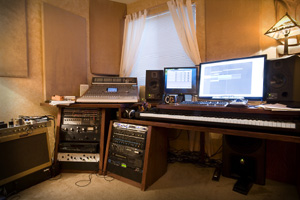by Rich Tozzoli
It doesn’t matter whether you have a $20,000 recording rig or the free version of GarageBand that came with your laptop: You need a comfortable, efficient setup in order to get ideas out of your head and onto a hard drive. Here are 7 fundamentals for planning and managing a recording setup that will free you up to think more about the music than the gear.
1. Positioning the monitors
Ideally you’ll be able create an equilateral triangle with your head as one point and the left and right monitors as the other two. Each should be the same distance from the other, and take into account leaning forward to use your keyboard and mix. If you’re positioned well relative to the monitors, your ears will be in the perfect position to capture a balanced stereo field. Be sure to “decouple” (separate) the monitors from a hard surface such as a desktop, which helps minimize the sound transmission from your speakers to the surface. Affordable choices include monitor stands and a cheap Auralex MoPad kit (around $30).
2. Managing cables
Piles of cables cause confusion. Use a simple labeler to mark each cable on both ends so you follow an output to an input. Make the letters as big as you can while still being able to read them wrapped around a cable or behind a console. Colored cables are also great for finding two ends of the same cable. To keep cables neat, bundle them using cheap, simple pipe insulation or the plastic cable wraps available at Radio Shack, office supply stores, and local music stores.
3. Minimize the MIDI
With the advent of so many amazing software synths, consider which of those old MIDI modules you really need, if any. (Sure, you’re attached to your Roland JV, but when was the last time you tracked with it?) By minimizing the amount of MIDI connections, you reduce your possibility for problems.
4. Consider USB keyboard controllers
If you’re ready to untangle yourself from MIDI (or never used it in the first place) you can easily control your software sounds with a USB keyboard controller. They’re affordable and plug directly into your computer. Higher-end modules even have transport controls and faders for mixing.
5. Use speaker cables for your speakers
Instrument cables and speakers cables both use ¼” phone jacks. However, instrument cables are shielded and speaker cables are not. Instrument cables are more vulnerable to picking up stray interference, so you don’t want to plug them into your monitors. Spend a few bucks for speaker cables.
6. Power time
Don’t plug equipment directly into your wall outlets. Power surges and voltage spikes can do more than cause hum — they can burn up gear. Protect your investments by using good power strips with surge protection. You also might consider a power conditioner (e.g., by Furman or Monster), which also help keep all those AC cables organized.
7. Ergonomics
Design your studio space and arrange your gear to fit the way you work. Also be aware that spending hours hunched over a keyboard, staring at a computer screen, can take a serious toll on your body. Get an adjustable stool that supports your back. Move your video monitor to the right height so you don’t strain your neck. Put your keyboard at a comfortable distance from your body. Have your controllers in a place where they’re easy to access; preferably, by just turning your chair. A workspace that functions well for you allows you to be more comfortable and helps the ideas flow more freely.
Rich Tozzoli is a Grammy-nominated engineer, mixer, producer and composer. He has worked with artists such as Ace Frehley, Al Di Meola and David Bowie, among many more, and is the author of Pro Tools Surround Sound Mixing. Rich is also a lifelong guitarist and composer. His work can be heard regularly on FoxNFL, HBO, and Discovery Channel, and he’s recently released the full-length CD Rhythm Up.
